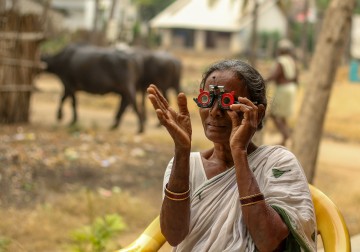In a new study from LVPEI, Drs. Srinivas Marmamula, Rohit C. Khanna, and others used RAVI, a rapid assessment method, to evaluate the prevalence, causes, and risk factors of visual impairment in the Nirmal district of Telangana.
An estimated 1.1 billion people around the world live with vision impairment (VI). The Indian subcontinent alone has over 335 million people with VI, 90% of which is treatable. Uncorrected refractive errors (UREs) and cataract are the leading causes of VI, both of which are easily treated using a pair of spectacles or surgery. Eye care service delivery, especially in a large and diverse country like India, is hampered by the lack of sub-population level data on VI, its prevalence, and causes. Epidemiological studies are cost-, time-, and labor-intensive, which make them difficult to implement in the world’s most populous country. The World Health Organization (WHO) has set global eye care targets to achieve a 30% increase in cataract surgery coverage and a 40% increase in effective refractive error coverage by 2030. India needs to have a better understanding of where we stand today, before we can show progress towards such goals.
Rapid assessment methods can be used to quickly gather epidemiological data at low cost. These methods use simplified sampling methods, rapid eye examination protocols, and easy data collection procedures on a large-scale in a cost- and time-efficient manner. Rapid assessment methods can also be modified to gather data for many eye diseases, including cataract, refractive errors, and diabetic retinopathy. Rapid Assessment of Visual Impairment (RAVI) is one such method, developed at LVPEI, which can be used to estimate VI and its causes. RAVI was originally designed to gather data from individuals aged 40 and above but has since been modified to screen VI in 16-year-olds and above. In a 2014 study, RAVI proved effective at estimating prevalence of VI among rural populations aged 40 and above, in the south Indian state of Telangana. But will RAVI still be effective at screening VI for a wider age range? Moreover, will it work as well for a sub-population of a Telangana?
In a new cross-sectional study published in the journal BMJ Open Access, Drs. Srinivas Marmamula, Rohit C. Khanna, and others from LVPEI used RAVI to evaluate the prevalence, causes, and risk factors associated with VI (visual acuity less than 6/12 in the better eye) in Nirmal district of Telangana. This paper is part of the wider Nirmal Eye Evaluation for Trends study. The population of Nirmal district was divided into 90 sampling clusters and 5,400 participants (4,629 examined), aged 16 years or older, were selected for the study. Over half (55%) of those examined were women, 2.3% self-reported to have diabetes, and 8.7% reported that they had hypertension.
Nirmal district has a VI prevalence of 8.1%. The leading cause and nearly half (49.5%) of all VI was due to UREs, followed by cataract (40.2%), and posterior segment and retinal disorders (4.9%) such as diabetic retinopathy or macular degeneration. Compared to the 2014 RAVI study, the team found that the prevalence of VI in Nirmal district has decreased by 19.3% (from 20.2% in 2014 to 16.3% in 2021-22) among those aged 40 or older. The study establishes RAVI as an effective rapid assessment method in eye care, even when screening younger people.
‘The observed decline in VI among middle-aged and older people indicates that eye care access in Nirmal district has improved,’ says Dr. Srinivas Marmamula, Network Associate Director of Public Health Research and Training at LVPEI and the principal author of this paper. ‘Increased eye care access should also be integrated with primary healthcare to help people with diabetes, who are susceptible to diabetic retinopathy and VI.’
Citation
Marmamula, S., Chinya, A., Yelagondula, V. K., Varada, R., Khanna, R. C., & Narayanan, R. (2024). Cross-sectional study of prevalence, causes and trends in visual impairment in Nirmal District, Telangana, India: Nirmal Eye Evaluation for Trends study. BMJ Open, 14(5), e083199. https://doi.org/10.1136/bmjopen-2023-083199
Photo credit: Srinivas Marmamula



